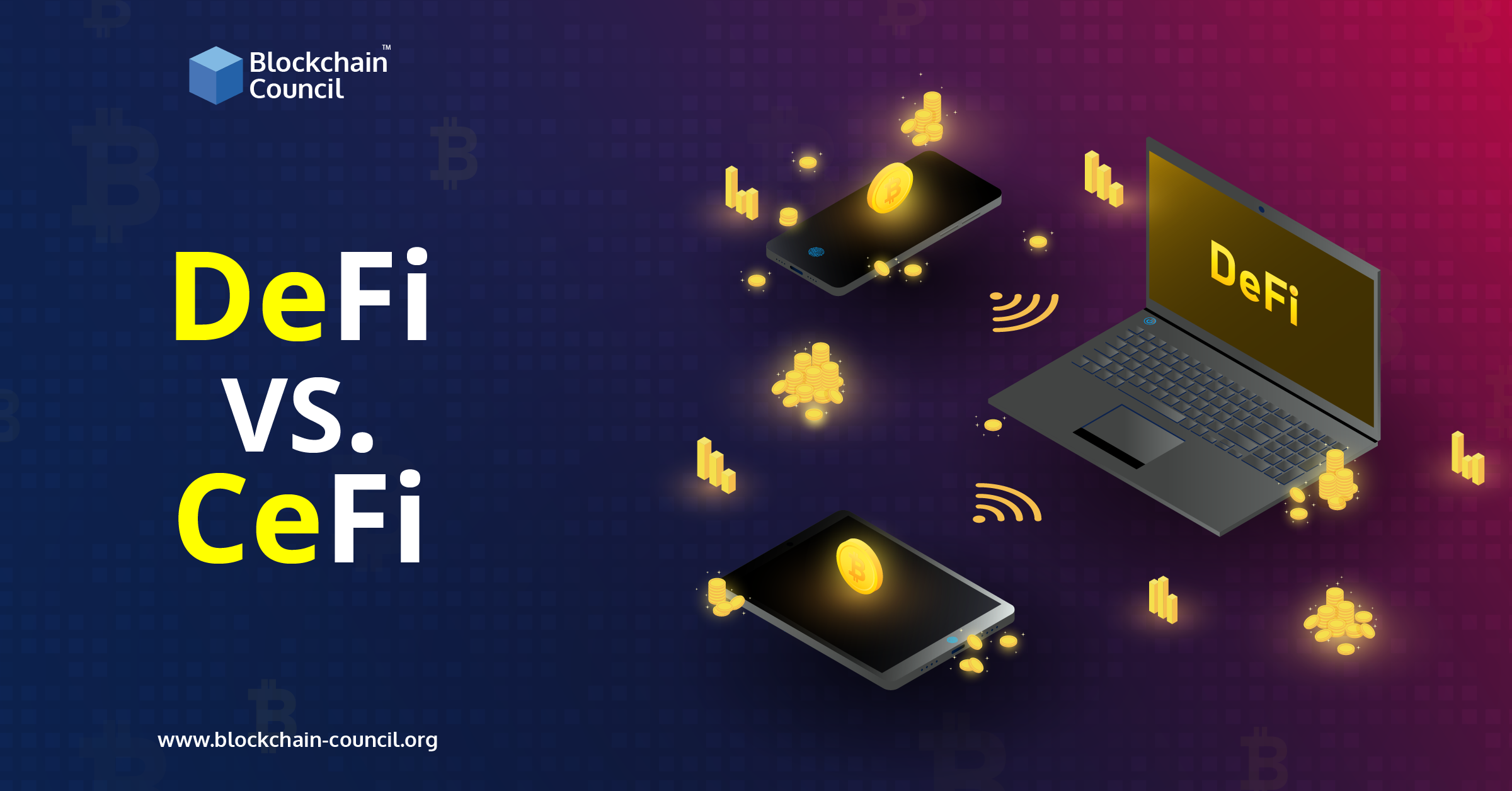
- Nitish Srivastava
- March 22, 2022
Consumers are generally unaware of the underlying laws or commitments that regulate financial assets and goods; therefore, the traditional centralized finance (CeFi) ecosystem may appear confusing to people.
Bitcoin launched a slew of innovative blockchain-based financial applications to the globe. Since the creation of Bitcoin, CeFi (Centralized Finance) appears to have entered deep waters. However, a new trend known as DeFi has evolved (Decentralized Finance). It has received a great deal of attention since its inception.
Decentralized Finance (DeFi) is building a reputation for itself as an ecosystem that promises transparency and control because of the underlying integrity-protected blockchain and greater financial asset yields than CeFi platforms. In addition, the wide spectrum that blockchain technology can offer has garnered the attention of learners to learn blockchain technology.
This article compares and contrasts DeFi and CeFi in terms of various aspects. To grasp the merits and limitations of CeFi and DeFi, we must first comprehend these two ideas.
What is CeFi (Centralized Finance)?
Before the introduction of DeFi, the norm for trading cryptos was Centralized Finance. As a result, it controls a significant portion of the bitcoin market.
CeFi services, such as centralized crypto exchanges, are managed by centralized corporations. As a result, most CeFi service providers have to follow the protocols drafted by the local governments in which they operate. These rules mandate anti-money laundering (AML) and Know Your Customer (KYC) policies for centralized financial organizations such as exchanges and trading platforms.
CeFi stores your cash in custodial wallets, which are centralized organizations and institutions. The private keys of users are stored in these crypto wallets. In exchange, these firms offer a variety of services to clients. Cryptocurrency trading is presently one of the most popular centralized financial alternatives. In addition to trading, companies affiliated with CeFi provide their customer’s services like borrowing, lending, margin trading, and so on.
Characteristics of CeFi
-
Centralized Exchange
Users can deposit assets in an internal account at a standard crypto exchange like Binance, Kraken, or Coinbase. However, even though money is held on the exchange, it remains out of the hands of users and is vulnerable to attacks if the exchange’s security protocols fail.
As a result, different security attacks have been launched against centralized exchanges. Customers who utilize centralized exchanges feel comfortable disclosing personal information and entrusting assets to these companies because they trust them.
Furthermore, big exchanges have whole departments dedicated to providing customer service to their customers. As a result, customers feel secure because of the high level of customer service, ensuring that their funds are in good hands.
-
Flexibility in fiat
Centralized services provide more flexibility than decentralized services when converting cash to bitcoin and vice versa. Normally, converting bitcoin to money requires the use of a centralized institution; however, DeFi services do not offer the same level of currency freedom with currency. In addition, client onboarding is straightforward in the Centralized Finance (CeFi) environment and may improve the customer experience.
-
Cross-chain services
CeFi services support LTC, XRP, BTC, and other currencies released on other blockchain platforms. However, because of the delay and complexity of executing cross-chain trades, DeFi services do not support these currencies. CeFi can circumvent this issue by securing custody of funds across many blockchains. CeFi has a tremendous advantage since several of the most commonly traded and highest-market-cap currencies exist on distinct blockchains and do not obey interoperability regulations.
What is DeFi (Decentralized Finance)?
The decentralized exchange does not involve any exchange. Instead, automated programs developed on blockchain platforms oversee the entire process. Decentralized finance also provides a fair and transparent financial system to which everybody may contribute. Moreover, it deploys blockchain technology to provide access to financial and banking services to unbanked individuals.
DeFi’s vision is to create a type of financial services ecosystem that is permissionless, open-source, and transparent. DeFi provides the benefit over CeFi to have total control over your assets and own the wallet’s key pair.
The decentralized financial system provides yield farming, asset storage, borrowing, crypto lending, and other services. Furthermore, users who wish to participate in DeFi must access DeFi services using decentralized apps (dApps) based on blockchain platforms.
Characteristics of DeFi
-
Permissionless
To utilize DeFi, users do not need authorization. However, consumers must first complete a KYC procedure, which requires them to provide personal information or make a financial deposit before using CeFi’s services.
Users can access the services using a wallet instead of providing personal information or depositing money with DeFi. It’s because DeFi is available to everyone without any restrictions or prejudice.
It offers a high level of accessibility and encourages community engagement. The products produced as part of the DeFi ecosystem are meant to complement one another. As a result, DeFi devices are frequently referred to as money legos.
-
Trustless
The main benefit of using DeFi services is that you don’t have to trust them to perform as stated. Users may ensure that DeFi services perform as planned by auditing their code and using external tools such as Etherscan to determine whether a transaction was completed correctly.
-
Advanced Innovation
Another notable benefit of DeFi is its advanced innovation. The Decentralized Finance Ecosystem is continuously optimizing its existing capabilities while also experimenting with new ones. From a build-centric environment to a varied ecosystem with ground-breaking financial services, the DeFi space has developed.
In domains where centralized financial services have evolved, the DeFi sector has been attempting to provide alternative means to manage the issue. To address DeFi’s inability to facilitate the transfer of incompatible cryptocurrencies like Bitcoin, solutions such as tBTC and WBTC, serve as a bridge by functioning as tokens linked to BTC’s value. Decentralized protocols are compatible with these solutions. It enables DeFi users to access Bitcoin without needing to use the token directly.
DeFi vs. CeFi : A Detailed Comparison
In the section below, we’ll go through the most common DeFi versus CeFi attributes.
-
Public validation
While the DeFi application code may not always be open-source, the execution and bytecode must be publicly verifiable on a blockchain in order for it to be categorized as non-custodial DeFi. As a result, unlike CeFi, each DeFi user may watch and verify that DeFi state changes are carried out in a timely manner. The new DeFi technology’s ability to communicate trust is unequaled because of its openness.
-
Control
DeFi, unlike CeFi, allows clients to control their assets directly at any moment bypassing the need for bank intervention. However, tremendous power comes with great responsibility. Users incur the majority of technical risks unless such insurance is insured. As a result, centralized exchanges, which are similar to conventional custodians, are becoming increasingly attractive for storing bitcoin assets.
-
Ease of handling
Permissionless blockchain users commonly discuss their transactions over a peer-to-peer network in public. Peers can engage in transaction fee bidding competitions to drive the transaction execution order because there is no persistent centralised body guiding transaction execution. As a result of this order malleability, which is now widely employed on blockchains, several market manipulation tactics have been established.
Regulatory bodies in CeFi, on the other hand, impose strict criteria on financial institutions and services, such as the implementation of transaction ordering. Due to the centralized structure of CeFi’s financial intermediaries, this is possible.
-
Trading in cryptocurrencies
CEXs work on the same fundamentals as their traditional counterparts. Limit order books, or off-chain records of outstanding orders placed by traders, are kept by CEXs. However, DEXs use AMM (automated market-maker) protocols to match the counterparties in a transaction, thus operating in a fundamentally different manner. AMMs calculate pricing depending on transaction volumes using mathematical algorithms.
-
Service charges
For spam prevention, service charges in DeFi, and blockchains, in particular, are critical. However, CeFi financial institutions may opt to provide free transaction services since they rely on customer anti-money laundering (AML) screening (or are compelled by governments to offer some services for free).
-
Confidentiality
Only blockchains with non-privacy-preserving smart contracts can use DeFi. As a result, rather than providing actual anonymity, these blockchains give pseudo-anonymity. Because centralised exchanges subject to anti-money laundering regulations are sometimes the only viable alternative for changing money into cryptocurrency assets, these exchanges have the authority to reveal address ownership to law authorities.
-
Arbitrage threats
To avoid price swings, an arbitrage should preferably operate atomically. Arbitrage on centralised and hybrid exchanges is essentially prone to market price volatility unless arbitrageurs engage with exchanges to assure execution atomicity.
Arbitrage between two decentralised exchanges on the same blockchain might be termed risk-free if transaction costs are ignored. The blockchain’s atomicity allows traders to create a smart contract that initiates the arbitrage and reverts if the arbitrage gets in loss. Arbitrage risk is analogous to a CEX and hybrid exchange when two DEXs on different blockchains are arbitraged.
-
Cross-chain services
CeFi services are often used for trading BTC and other significant currencies issued on separate blockchains. DeFi services, on the other hand, seldom provide these currencies owing to the complexity and time necessary to perform atomic cross-chain exchanges.
CeFi’s services address this issue by storing assets from a number of sources. However, to achieve interoperability decentralized services require tokens that abide by Ethereum token standards.
CeFi has a significant advantage here since many of the world’s most valuable and regularly traded currencies are hosted on other blockchains that do not adhere to interoperability requirements.
-
Flexibility in Fiat conversion
When it comes to moving money from one currency to another, centralised services are usually more flexible than decentralised services. Most DeFi providers, for example, do not allow fiat on-ramps since money to cryptocurrency conversion requires a centralised institution. Customers may also be onboarded faster in CeFi, contributing to a better customer experience.
Conclusion
DeFi and CeFi share a common goal to serve clients with high-quality financial goods and services while simultaneously boosting the economy. But, to summarise, both DeFi and CeFi have advantages and disadvantages, and there is no straightforward way to integrate the finest features of both systems.
Therefore, these two are distinct yet interconnected financial systems that will coexist and mutually benefit.
If you are interested in blockchain development, then you have clicked at the right place. Blockchain council offers some of the best blockchain certification courses that you can enroll in and enter the world of blockchain.





































































 Guides
Guides News
News Blockchain
Blockchain Cryptocurrency
& Digital Assets
Cryptocurrency
& Digital Assets Web3
Web3 Metaverse & NFTs
Metaverse & NFTs
